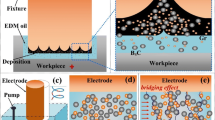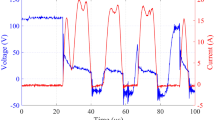Abstract
EDM technology is still facing a big bottleneck problem unsolved: low molten material removal rate, resulting in low machining speed and poor surface quality. To improve the material removal amount in each discharge process of EDM, the composite pulse current waveforms were proposed. The single pulse discharge experiments demonstrate that under the same discharge energy, the material removal volume in the discharge with the end composite pulse could be twice as high as that with the square pulse. Furthermore, due to high molten material removal rate of the end composite pulse, the thickness of the recast layer generated in the discharge with the end composite pulse was much thinner than that with the square pulse under the same discharge energy. The MD simulation results also revealed that in the discharge with the end composite pulse, the basic current mainly melted the material to form a larger molten pool, then, the inrush current, which had higher energy density and higher material removal motivity, could remove the molten pool material largely. Thus, the end composite pulse can improve the molten material removal rate and decrease the recast layer. Finally, EDM milling experiments show that higher average material removal volume in each discharge process of EDM milling with the end composite pulse was the main reason for higher material removal rate (MRR) in EDM milling with the end composite pulse. In addition, the relative tool wear ratio (RTWR) in EDM milling with the end composite pulse can be approximately equal to or slightly lower than that with the square pulse at a high material removal rate in EDM milling, which shows a great application potential of the end composite pulse in EDM.





















Similar content being viewed by others
Data Availability
Not applicable
Code availability
Not applicable
References
Li ZK, Tang JJ, Bai JC (2020) A novel micro-EDM method to improve microhole machining performances using ultrasonic circular vibration (UCV) electrode. Int J Mech Sci 175:105574
Zhang YZ, Liu YH, Shen Y, Ji RJ, Li Z, Zheng C (2014) Investigation on the influence of the dielectrics on the material removal characteristics of EDM. J Mater Process Tech 214:1052–1061
Li Q, Yang XD (2023) Thermo-hydraulic analysis of melt pool dynamics and material removal on anode in electrical discharge machining. International Journal of Heat and Mass Transfer 203:123816
Pujiyulianto E, Suyitno (2021) Effect of pulse current in manufacturing of cardiovascular stent using EDM die-sinking. Int J Adv Manuf Tech 112:3031–3039
Yue XM, Yang XD, Kunieda M (2018) Influence of metal vapor jets from tool electrode on material removal of workpiece in EDM. Precis Eng 53:278–288
Koyano T, Hosokawa A, Suzuki S, Ueda T (2015) Influence of external hydrostatic pressure on machining characteristics of electrical discharge machining. Cirp Ann-Manuf Techn 64:229–232
Koyano T, Suzuki S, Hosokawa A, Furumoto T (2016) Study on the effect of external hydrostatic pressure on electrical discharge machining. Procedia CIRP 42:46–50. https://doi.org/10.1016/j.procir.2016.02.184
Kunieda M, Miyoshi Y, Takaya T, Nakajima N, Yu ZB, Yoshida M (2003) High speed 3D milling by dry EDM. Cirp Ann-Manuf Techn 52:147–150
Yu ZB, Jun T, Kunieda M (2004) Dry electrical discharge machining of cemented carbide. J Mater Process Tech 149:353–357
Zhang QH, Zhang JH, Deng JX, Qin Y, Niu ZW (2002) Ultrasonic vibration electrical discharge machining in gas. J Mater Process Tech 129:135–138
Zhang QH, Zhang JH, Ren SF, Deng JX, Ai X (2004) Study on technology of ultrasonic vibration aided electrical discharge machining in gas. J Mater Process Tech 149:640–644
Xu MG, Zhang JH, Li Y, Zhang QH, Ren SF (2009) Material removal mechanisms of cemented carbides machined by ultrasonic vibration assisted EDM in gas medium. J Mater Process Tech 209:1742–1746
Heinz K, Kapoor SG, DeVor RE, Surla V (2011) An Investigation of Magnetic-Field-Assisted Material Removal in Micro-EDM for Nonmagnetic Materials. J Manuf Sci E-T Asme 133:021002
Bhattacharya A, Batish A, Bhatt G (2015) Material transfer mechanism during magnetic field-assisted electric discharge machining of AISI D2 D3 and H13 die steel. P I Mech Eng B-J Eng 229:62–74
Govindan P, Gupta A, Joshi SS, Malshe A, Rajurkar KP (2013) Single-spark analysis of removal phenomenon in magnetic field assisted dry EDM. J Mater Process Tech 213:1048–1058
Joshi S, Govindan P, Malshe A, Rajurkar K (2011) Experimental characterization of dry EDM performed in a pulsating magnetic field. Cirp Ann-Manuf Techn 60:239–242
Shabgard MR, Gholipoor A, Mohammadpourfard M (2019) Investigating the effects of external magnetic field on machining characteristics of electrical discharge machining process numerically and experimentally. Int J Adv Manuf Tech 102:55–65
Tachibana H, Kunieda M (2016) The influence of discharge waveforms on the process of crater forming. Proceedings of 2016 Annual Meeting of JSEME :35-38. (In Japanese)
Shinohara M, Kunieda M (2020) Influences of discharge current pulse shape on machining characteristics in EDM. Procedia CIRP 95:200–203
Jithin S, Raut A, Bhandarkar UV, Joshi SS (2020) Finite element model for topography prediction of electrical discharge textured surfaces considering multi-discharge phenomenon. Int J Mech Sci 177:105604
Liang SY, Shih AJ (2016) Analysis of Machining and Machine Tools, 1st edn. Springer, New York, NY
Yue XM, Yang XD (2020) Molecular dynamics simulation of material removal process and mechanism of EDM using a two-temperature model. Appl Surf Sci 528:147009
Yue XM, Yang XD (2017) Molecular dynamics simulation of single pulse discharge process: clarifying the function of pressure generated inside the melting area in EDM. Mol Simulat 43:935–944
Yue XM, Chen ZY, Xu ZK, Liu J (2022) EDM milling based on a 6-DOF serial robot. Int J Adv Manuf Tech 123:1905–1912
Funding
The authors would like to thank the project funded by China Postdoctoral Science Foundation (No.2022T150383) and the National Natural Science Foundation of China (No. 51905311).
Author information
Authors and Affiliations
Contributions
X Y: Conceptualization, Investigation, Validation, Visualization, Writing - original draft, Funding acquisition. Q S: Data curation, Visualization. Ji F and J H: Formal analysis, Methodology. Q Z: Project administration, Supervision, Resources, Writing - review & editing.
Corresponding author
Ethics declarations
Ethics approval
Not applicable
Consent to participate
Not applicable
Consent for publication
Not applicable
Competing interests
The authors declare no competing interests.
Additional information
Publisher’s note
Springer Nature remains neutral with regard to jurisdictional claims in published maps and institutional affiliations.
Rights and permissions
Springer Nature or its licensor (e.g. a society or other partner) holds exclusive rights to this article under a publishing agreement with the author(s) or other rightsholder(s); author self-archiving of the accepted manuscript version of this article is solely governed by the terms of such publishing agreement and applicable law.
About this article
Cite this article
Yue, X., Sun, Q., Fan, J. et al. High-efficiency EDM based on a composite pulse current. Int J Adv Manuf Technol 127, 1433–1446 (2023). https://doi.org/10.1007/s00170-023-11518-7
Received:
Accepted:
Published:
Issue Date:
DOI: https://doi.org/10.1007/s00170-023-11518-7




